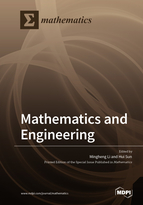Mathematics and Engineering
A special issue of Mathematics (ISSN 2227-7390). This special issue belongs to the section "Engineering Mathematics".
Deadline for manuscript submissions: closed (30 November 2020) | Viewed by 57841
Special Issue Editors
Interests: chemical vapor deposition; membrane processes; water desalination; adsorption; process systems engineering (design, simulation, control, and optimization)
Special Issues, Collections and Topics in MDPI journals
Interests: mathematical modeling; scientific computations; dynamical systems
Special Issues, Collections and Topics in MDPI journals
Special Issue Information
Dear Colleagues,
Engineering problems arising in energy, environment, materials and healthcare are featured by enormous scale and complexity, which have posed challenges and provided opportunities for the development of advanced mathematical tools to ensure sound decision making. For example, with the breakthrough of computational power over the last few decades, modeling and numerical linear algebra have been intensely utilized and developed to simulate various engineering processes. More recently, data sciences and machine learning emerge in a diverse collection of engineering fields.
The aim of this Special Issue is to bring together recent progresses in mathematics applied in complex engineering problems, which include, but are not limited to, modeling and simulation, computations, analysis, control, optimization, data science, and machine learning.
Prof. Dr. Mingheng Li
Prof. Dr. Hui Sun
Guest Editors
Manuscript Submission Information
Manuscripts should be submitted online at www.mdpi.com by registering and logging in to this website. Once you are registered, click here to go to the submission form. Manuscripts can be submitted until the deadline. All submissions that pass pre-check are peer-reviewed. Accepted papers will be published continuously in the journal (as soon as accepted) and will be listed together on the special issue website. Research articles, review articles as well as short communications are invited. For planned papers, a title and short abstract (about 100 words) can be sent to the Editorial Office for announcement on this website.
Submitted manuscripts should not have been published previously, nor be under consideration for publication elsewhere (except conference proceedings papers). All manuscripts are thoroughly refereed through a single-blind peer-review process. A guide for authors and other relevant information for submission of manuscripts is available on the Instructions for Authors page. Mathematics is an international peer-reviewed open access semimonthly journal published by MDPI.
Please visit the Instructions for Authors page before submitting a manuscript. The Article Processing Charge (APC) for publication in this open access journal is 2600 CHF (Swiss Francs). Submitted papers should be well formatted and use good English. Authors may use MDPI's English editing service prior to publication or during author revisions.
Keywords
- mathematical models
- systems of differential equations
- complex engineering systems
- scientific computation
- asymptotic analysis
- control theory
- optimization
- data science
- machine learning







